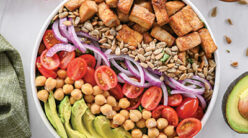We’ve all seen the pattern, either in ourselves or in a friend: We get frustrated with our tight jeans, reach the point of “enough is enough,” and decide to overhaul our lives with a strict diet.
For a few months, things are great. We might feel better. We might drop an impressive amount of weight. And then, despite our best intentions, we fall off the bandwagon.
Study after study shows that this pattern is ubiquitous among dieters, regardless of which fad diet they choose. “We’re very successful at helping people lose weight with a multitude of different kinds of diets, but what we can’t do is help them maintain that weight loss,” says Lesley Lutes, Ph.D., associate professor of psychology at the University of British Columbia. “At six months, people seem to plateau with their weight loss. Then people regain all their weight across time—50 percent of it within the first year.”
A large part of the problem is that extreme diets make us miserable. Dieters typically report strong feelings of deprivation and low satisfaction, says Lutes, and their discontent only increases over time as the restrictions of their diet start to feel increasingly burdensome.
So what about abandoning extreme dieting and focusing instead on small, incremental improvements to your routine—“tweaks” that improve health but don’t feel catastrophic, and that you can stick with for the long run?
That’s an approach favored by Taylor Wolfram, M.S., R.D.N., L.D.N., a dietitian in private practice in Chicago, Illinois. The goal, she suggests, should be habit formation, not quick fixes. “I like to tell clients, ‘Don’t make a change that you can’t keep forever,’ because I like to focus on sustainability,” says Wolfram. “Chip away at the iceberg a little bit at a time. So you’re going to make one little change, and once you get that down and that feels like a manageable habit, then, okay, add in something else.”
But can “small tweaks” actually make a difference in your health? Absolutely, says Lutes. In one weight-loss study from researchers at Tufts University, overweight volunteers were divided into two groups: One group was put on a relatively mild diet that restricted their calorie intake by 10 percent, and the other was put on a diet restricting calorie intake by 30 percent. The volunteers on the more extreme diet lost weight at a faster pace for the first six months—but after six months, their weight started to creep back up. By contrast, those on the milder diet tended to hold steady in their weight after the six-month mark. In the end, the two groups showed almost the same amount of weight loss after a one-year period compared to when they started.
So if “tweaks” are an effective way of improving health, what “tweaks” give the biggest bang for the buck? To find out, we surveyed six registered dietitians with this question: “If you could convince all Americans to make just one small change to their dietary habits or to their mind-set about food, what would it be?” Here’s what they said:
[1] Eat a cup of veggies at lunch.
Sharon Palmer, R.D.N., the “Plant-Powered Dietitian” and author of The Plant-Powered Diet
According to Palmer, increasing veggie intake is the single most powerful change most Americans can make for their health.
“Vegetables are very high in fiber, high in phytochemicals, high in antioxidants, and low in calories,” says Palmer. Not only are they highly nutritious, but prioritizing veggies also leaves less room for less healthy alternatives. “By eating more veggies, you crowd out other less healthful foods in your diet,” says Palmer.
Unfortunately, only nine percent of Americans actually eat the recommended daily quantity of vegetables. A major reason for this, says Palmer, is that many people don’t start eating their daily veggies until dinnertime, making it impossible to eat enough. To get in all the veggies your body needs, start munching at least by lunchtime (or at breakfast!).
Salad or carrot sticks, steamed broccoli or sautéed kale—the options are endless. Eat your veggies raw or cooked; you’ll reap the benefits either way.
[2] Add in one serving of leafy greens
per day.
Taylor Wolfram, M.S., R.D.N., L.D.N., private practice dietitian in Chicago, Illinois
Leafy green vegetables are packed full of vitamins and nutrients, especially vitamin A, C, K, and folate, says Wolfram. Some are also rich in calcium. And leafy greens are fairly versatile, so it’s easy to sneak their nutritional benefits into your diet.
“You can have them raw in a salad, or you can put them into basically anything you’re cooking, like soup, stew, tacos, or a casserole,” says Wolfram.
Aim to get at least one serving of leafy greens per day, but set a manageable goal relative to where you’re starting from, says Wolfram. If leafy greens are a new addition to your diet, start with just one serving per week, and build up from there. Also, pick vegetables you like. If you don’t like kale, go with spinach instead, says Wolfram. Then experiment with different ways of preparing your greens (Wofram’s favorite method is to sauté greens with a little garlic and olive oil). “It’s really important to find food that you think tastes good and to prepare it in a way you enjoy,” she explains.
[3] Move away from categorizing food
in terms of protein, carbs, or fats.
Julieanna Hever, M.S., R.D., C.P.T., the “Plant-Based Dietitian” and author of Plant-Based Nutrition (Idiot’s Guide) and The Vegiterranean Diet
“Over the past century, we have embraced the use of the nutritional biochemistry terms ‘protein,’ ‘carbohydrates,’ and ‘fats’ as food groups,” says Hever. “This has lead to us characterizing foods based on their predominant macronutrient and using this idea for fad dieting techniques, such as eliminating carbohydrates or fats or the never-ending pursuit of ‘enough protein.’”
Unfortunately, looking at macronutrients alone can be very misleading. Donuts and whole grain bread are both “carbohydrates,” for example, but donuts have very little nutritional value, whereas whole grain bread actually has quite a bit. Focusing on macronutrients simply doesn’t tell the full story.
Instead of worrying about the macronutrients in each food, focus on eating a variety of whole plant foods, including fruits, vegetables, whole grains, legumes (like beans and lentils), nuts, and seeds. If you fill your plate with a variety of whole plant foods, you’ll naturally get the protein you need, and you’ll be eating the right kinds of fats and carbohydrates.
“From the scientific literature, we know that eating plenty of whole plant foods and minimizing/avoiding animal products and highly refined food products, such as sugars and oils, are the key to optimal health,” says Hever.
[4] Move toward unsweetened beverages.
Marissa Podell, M.S., R.D., private practice dietitian in Los Angeles, California
Sweetened drinks—including soda, sweetened coffee, sweetened tea, juice, and even sweetened plant-based milks such as soy or almond milk—contain lots of extra calories from sugar, but they aren’t very satiating and don’t make you feel as full as calories you eat in solid food, says Podell. This makes sugary drinks a major contributor to obesity risk. Since many Americans consume at least one sugary beverage every day, finding unsweetened alternatives is a high-impact tweak that makes a huge difference in your sugar consumption—and your overall health.
Baby steps are okay. You can start by dropping back to half your usual weekly soda consumption, for instance. As for what to drink instead, water is always the ideal. But if water isn’t cutting it, says Podell, try sparkling water in place of soda, or unsweetened herbal tea instead of sweetened tea.
One note of caution: Don’t assume that fruit juice is a good alternative to other sweet drinks. “When the fruit is processed into juice, the fiber is removed,” says Podell. “There are a lot of health benefits in fruit when the fiber is still present, but consuming fruit in whole food form is always best.” To get that fruity breakfast drink you crave, opt for a smoothie made with whole fruit instead of just juice.
[5] Read ingredient labels.
Eliza Savage, M.S., R.D., C.D.N., private practice dietitian in New York, New York
“Far too often, I see patients who are consuming ‘replacement’ foods that they believe are healthy but are actually filled with artificial sweeteners, fillers, and other questionable ingredients,” says Savage.
When you’re reading the ingredient label, look for simple, familiar ingredients. If you don’t recognize or understand many of the ingredients, opt for a different product. An unintelligible ingredient list is a clue that a food is highly processed and contains unhealthful additives.
Even better, says Savage, choose more foods that don’t have nutrition labels—foods like fruits and vegetables. “By simplifying ingredients, Americans can improve their overall nutrition choices but also take responsibility for what is (and isn’t) in their meals,” says Savage.
[6] Swap white bread
for whole grain.
Keri Gans, M.S., R.D., C.D.N., author of The Small Change Diet
Whole grain bread has more fiber than white bread, says Gans. “The more fiber in your diet, the fuller you will become at meals, and the less likely to overeat.” Whole grain bread also contains more protein, vitamins, minerals, and antioxidants than white bread.
While eating refined grains (like white flour, white bread, and white pasta) is associated with a host of health problems, whole grains are a completely different story. Multiple studies have found that eating more whole grains significantly lowers the risk of conditions like heart disease and obesity.
Look for a brand that explicitly states that it is 100 percent whole grain, says Gans. Once you’ve gotten into the habit of whole grain bread, you can branch out to other whole grain swaps as well. For example, try subbing whole grain (brown) rice for white rice. Or try whole grain pasta instead of white pasta.
Jamie Santa Cruz is a health and medical journalist based in Colorado.






